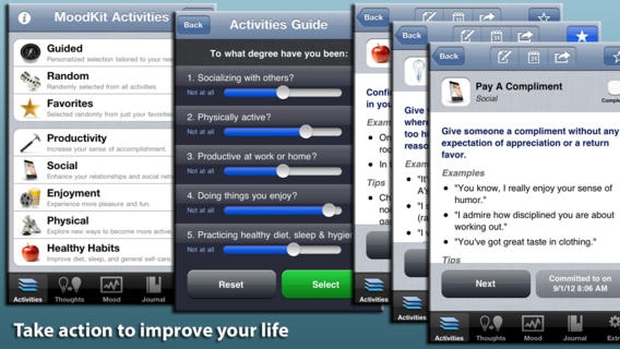Improving your mood can begin with a phone download. And from there—perhaps you would care for a magnetic mental massage? MoodKit is a smartphone app that can help treat depression and other psychological problems. MoodKit employs the tools of a technique called cognitive behavioural therapy. This app has featured in leading newspapers and has been approved by England’s National Health Service (NHS) as a “safe” and “trustworthy” health app.Depression currently affects 1 in 10 Americans, according to the Centers for Disease Control and Prevention. The basic idea is that depression results in patterns of behaviour and thought that reinforce depression. For instance, if a person is spending most of the day in bed thinking he will never be happy again because he has just lost a loved one, his depression may persist because he is spending most of the day in bed thinking he will never be happy again. In many cases, getting the person out and about and thinking about the stuff of everyday life is all it takes to lift the clouds.
Drew Erhardt, a psychology professor at Pepperdine University, came up with MoodKit. “Being depressed can cause us to look at our situation in distorted, unhelpful ways,” Erhardt says. “And we tend to pull back from activities that might otherwise boost our mood, like exercise, interacting with others, and going to enjoyable places.”
Cognitive behavioural therapy prods patients to do things that will make them feel a sense of accomplishment and connection, and to avoid interpreting situations as being worse than they are. Clinical studies have consistently shown that this approach is a relatively fast and effective treatment, with outcomes at least as good as those achieved by antidepressant medications like Prozac, and without the drugs’ side effects.
Think About Beer and Italy
Loaded into a smartphone, MoodKit prompts users to link their moods, activities, and thoughts. For example, it might indicate that a user’s low point coincides with thinking his friends don’t care about him, or with eating at a fast-food restaurant. It might then help the user think about making weekend plans or eating in a park, activities associated with high points in his mood. Such guidance has long been available in books, but the phone’s interactivity, ubiquity, and privacy offer big advantages. “People don’t want to pull out Overcoming Your Personality Disorder when they’re in Starbucks,” Erhardt says—a mistake that I, for one, will never make again.

Studies of MoodKit’s effectiveness aren’t in yet. But for what it’s worth, the app is being used by thousands of people. As effective as cognitive behavioural therapy can be, though, being told to fix your mood problems by working on your thinking and behaviour is a little like being told by the doctor to fix your cold by resting up and drinking plenty of liquids. It’s good advice, but it leaves you wishing you could just get a prescription for something that directly blasts away at the root of the problem. Tarique Perera is taking more of that direct-fix approach. A Harvard-trained psychiatrist and formerly a professor at Columbia University, Perera is a leading practitioner of a brain-altering process known as trans cranial magnetic stimulation, or TMS. Electromagnetic coils are positioned near a patient’s skull to deliver brief pulses of magnetic fields; these induce electric currents inside the head, which cause neurons to fire in brain regions associated with mood.

Introduced in 1985, TMS was approved by the U.S. Food and Drug Administration four years ago for the treatment of depression. Using electricity to affect the brain makes TMS sound similar to electroconvulsive therapy, alias electroshock therapy. But whereas the latter blankets large swaths of the brain with a whiteout storm of electrical activity—leading to temporary, and occasionally permanent, memory impairment—TMS is more of a focused tickle of the circuitry. Although the exact process by which magnetic stimulation relieves depression remains an open question, TMS practitioners have reported that about 60 percent of patients see a remission of their symptoms. Perera, who has recently established his own TMS clinic, describes this approach as “the future of neuropsychiatry’ Terrified (like most technophiles) at the thought of being left behind in an earlier century, I tried to get someone in my area to magnetically scour away my non existent depression. But they all refused, citing various vague ethical concerns over physically altering the brain of someone who doesn’t have a diagnosis.
Let Bacteria Lift Your Mood
Well, who needs TMS when you can have magnetic nanoparticles injected directly into your brain? Arnd Pralle, a physics researcher at the State University of New York at Buffalo, has developed a technique for employing magnetic fields to heat up nanoparticles that have been implanted in neurons. The heat activates temperature-sensitive channels in the cells and stimulates potentially beneficial changes in the neural circuitry. At least, that is the theory.
So far Pralle has proved that his nanoparticles can affect the behaviour of nematodes, causing the roundworms to change their direction of motion. He has also shown that the technique stirs changes in mouse cells in petri dishes. Although Pralle and others involved in this suddenly hot research field haven’t demonstrated that the trick works in the brains of living animals, there is good reason to believe it will. Researchers have for years been triggering neuronal firing, and specific behaviours such as eye movements in primates, by performing a similar trick with laser light instead of heat, a well-established approach called optogenetics.

The big drawback to optogenetics is that it requires surgically implanting optical fibers in the brain. Although that has been done many times in a variety of animals, it is not something people would like to be done to them, in spite of the potential for making them a hit at parties. Pralle’s approach, on the other hand, merely requires injecting a needle full of magnetically sensitive nanoparticles into specific brain areas. Magnetic fields can then be beamed in from the outside. That sounds like something the people could live with.
Even better, Pralle is working on a technique that should do away with the need to inject anything at all. In optogenetics, researchers make brain cells responsive to light by stealing genes from light-sensitive bacteria and then packing those genes into a virus that infects an animal’s brain cells. “Were looking at bacteria that make magnetic nanoparticles, so we can insert their genes into brain cells in the same way Pralle says. The result would be an ability to get specific brain circuits to fire, just as optogeneticists do now. And that could open the door to all sorts of psychological treatments.
“This would be a way to fix depression and other disorders that is much more specific to the groups of neurons that are causing the problems,” Pralle explains. “Other techniques are very generic to most of the brain in comparison, which makes them less effective and causes them to have other effects on the brain.” What’s not to like about shooting bacteria genes into your brain to have your thoughts magnetically manipulated?
Its still early days but definitely these methods seem to be going in the right direction. The unison of mind and body is an important ingredient of understanding oneself first and unless our mind is clear in thoughts our actions will remain in doubt.
Source: David Freeman, a Freelance Journalist, author for Discover Magazine (Jan-Feb 2013).



































